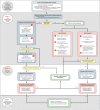Screening, evaluation, and early management of acute aortic dissection in the ED
- PMID: 22708909
- PMCID: PMC3406274
- DOI: 10.2174/157340312801784970
Screening, evaluation, and early management of acute aortic dissection in the ED
Abstract
Acute aortic dissection (AAD) is a rare and lethal disease with presenting signs and symptoms that can often be seen with other high risk conditions; diagnosis is therefore often delayed or missed. Pain is present in up to 90% of cases and is typically severe at onset. Many patients present with acute on chronic hypertension, but hypotension is an ominous sign, often reflecting hemorrhage or cardiac tamponade. The chest x-ray can be normal in 10-20% of patients with AAD, and though transthoracic echocardiography is useful if suggestive findings are seen, and should be used to identify pericardial effusion, TTE cannot be used to exclude AAD. Transesophageal echocardiography, however, reliably confirms or excludes the diagnosis, where such equipment and expertise is available. CT scan with IV contrast is the most common imaging modality used to diagnose and classify AAD, and MRI can be used in patients in whom the use of CT or IV contrast is undesirable. Recent specialty guidelines have helped define high-risk features and a diagnostic pathway that can be used the emergency department setting. Initial management of diagnosed or highly suspected acute aortic dissection focuses on pain control, heart rate and then blood pressure management, and immediate surgical consultation.
Figures
References
-
- Hansen MS, Nogareda GJ, Hutchison SJ. Frequency of and inappropriate treatment of misdiagnosis of acute aortic dissection. Am J Cardiol. 2007;99(6):852–856. - PubMed
-
- Sullivan PR, Wolfson AB, Leckey RD, Burke JL. Diagnosis of acute thoracic aortic dissection in the emergency department. Am J Emerg Med. 2000;18(1):46–50. - PubMed
-
- Elefteriades JA, Barrett PW, Kopf GS. Litigation in nontraumatic aortic diseases--a tempest in the malpractice maelstrom. Cardiology. 2008;109(4):263–272. - PubMed
-
- Olsson C, Thelin S, Ståhle E, Ekbom A, Granath F. Thoracic aortic aneurysm and dissection: Increasing prevalence and improved outcomes reported in a nationwide population-based study of more than 14,000 cases from 1987 to 2002. Circulation. 2006 Dec 12;114(24):2611–2618. - PubMed
-
- Clouse WD, Hallett JW, Schaff HV, et al. Acute aortic dissection: Population-Based incidence compared with degenerative aortic aneurysm rupture. Mayo Clin Proc. 2004;79(2):176–80. - PubMed
Publication types
MeSH terms
LinkOut - more resources
Full Text Sources
Medical



